time slips in an other place
gail priest: trace elements, yokohama triennale
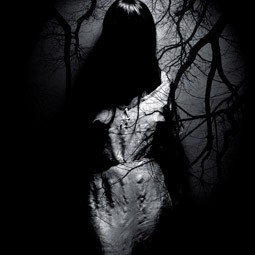
Jane Burton, Wormwood I (2006-7)
Courtesy of the artist and Bett Gallery, Hobart; Heiser Gallery, Brisbane; Johnston Gallery, Perth; Karen Woodbury Gallery,
Jane Burton, Wormwood I (2006-7)
FOR HALF THE YEAR TOKYO IS ONLY ONE HOUR BEHIND SYDNEY—SO CLOSE YOU CAN CONDUCT NORMAL BUSINESS ACTIVITIES AND MAINTAIN RELATIONATIONSHIPS AS IF YOU WERE JUST IN ANOTHER PART OF AUSTRALIA. MELATONIN LEVELS ARE RELATIVELY UNMODIFIED WHILE SENSES AND SOUL ARE OVERWHELMED BY OTHERNESS. PERHAPS THIS IS WHAT MAKES TOKYO FEEL NOT SO MUCH LIKE A FOREIGN COUNTRY BUT MORE LIKE A PARALLEL UNIVERSE.
trace elements
I was in this parallel universe for seven weeks undertaking a residency at Tokyo Wonder Site Aoyoama. Co-initiated by Artspace, Sydney the residency culminated in a group exhibition, Diorama of a City: Between Site and Space with fellow Australian artists Alex Gawronski and Tim Silver and Japanese artists Hiraku Suzuki, Exonemo and Paramodel. Co-incidentally another Australian/Japanese collaborative exhibition had just opened at Tokyo Opera City—Trace Elements: spirit and memory in Japanese and Australian photomedia—curated by Bec Dean from Performance Space with Shihoko Iida.
As with most activities I undertook in Japan, I got the instructions slightly wrong and entered the exhibition via the exit. This meant that the eroto-gothic photo manipulations, Wormwood (2005-07) by Jane Burton (Australia), were my introduction—sensual curves of female bodies caressed by shadows and forest branches. Burton’s images are richly evocative of adult fairy tales, perhaps a little undercut by the sterile corridor in which they are hung. However the resonance with Lovers (1994) by Teiji Furuhashi (Japan) in the next room installation serves as the correction.
As the video artist for Dumb Type it’s not surprising that Furuhashi’s is quite a performative installation. Images of naked people walk slowly around the four walls, meeting, embracing, passing through and by each other. Slide projectors on turntables rotate around the large room casting scanning lines across the images, while ceiling-rigged projectors throw messages onto the floor: “do not cross the line…” Melancholic chimes ring out, setting the meditative pace of the work that is all activity but with curiously little action. Its overly fussy mechanics reveal this is an early example of an immersive ‘multimedia’ environment.
Mixing with Furuhashi’s chimes are the clamouous explorations of Philip Brophy’s Evaporated Music (Part 1 A-F [2002-04, Aus]), in which the artist has remade the soundtracks to a series of popular music video-clips. Treating myself to the comfortable armchair I experienced the horror show that Brophy has made of Celine Dion’s ‘It’s all coming back to me now.’ The diva croaks through her lyrics, in desperate need of an exorcist, accompanied by wild foley and swirling 5.1 spatialisation. Infinitely more interesting than the original clip, full of film soundscape theory experiments, Brophy’s work provided a spikey element within the generally contemplative exhibition.
Continuing my backwards journey I worked from end to beginning across Japanese expatriate Seiichi Furuya’s series of images of his wife Christine. This course allowed me a little more ambiguity, and sense of discovery, in what is essentially a linear pictorial essay of love and loss. Accompanied by a booklet of excerpts from both Furuya’s and his subject’s diaries, the photos are mostly snapshots, personal moments, forming a deeply moving document of love and the tragic decline of a woman into irrevocable despair. Furuya has also made several publications, rearranging and regrouping the images to make sense of the course of events. Learning this later in the bookshop, I find the artist’s obsessive remembering even more tragic.
The small and seemingly unassuming works of Lieko Shiga (Japan) offer much for contemplation in their surrealistic photomontage of humble snapshots and provide a nice foil to fellow Japanese artist Kazuna Taguchi’s slick monotones of young girls treated with an etching-like finish. Poses are contrived, faces disappearing into contentless backgrounds. The irony of the images creeps up on you.
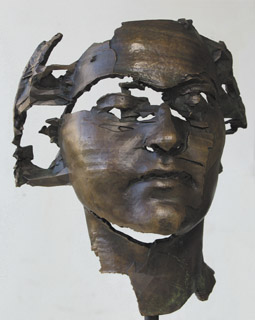
Sophie Kahn, Head of a Young Woman (2004)
courtesy the artist
Sophie Kahn, Head of a Young Woman (2004)
Taguchi’s cool and efficient pieces are in turn a nice match for the prints of Sophie Kahn (Aus/US) exploring the medical imaging of her body—twisted vectors alluding to muscle and bone. The body is simultaneously seen from inside and out, fractured by movement, refusing to be finally known. Also exhibited is a bronze cast of Kahn’s head—like a death mask—the brutal gouges and gashes made from finessing processing glitches rendering it both beautiful and disturbing.
An undercurrent of the exhibition was the relationship between moving and still images and their different powers as vehicles of memory. Genevieve Grieves’ video work, Picturing the Old People (2005), dresses contemporary Indigenous Australians in turn of the century clothing, re-enacting the portraiture of the time. These subjects refuse to remain still, to become the forgotten anonymous ‘natives’ of the archival images that Grieves was researching through the State Library of Victoria. It is a neatly conceived work, full of meaning for both Australian history and the history of photography and its role and responsibilities in documenting culture.
She dissolves (2000) by Chie Matsui (Japan) was a curious work secreted on tiny monitors in several parts of the gallery. The artist’s first video creation, it documents a performance in which a woman repeatedly disappears down a ladder under the floor and reappears a few minutes later soaking wet, up another ladder back into the room in a seemingly endless cycle.
This pared-back performance documentation modality appeared in several pieces I experienced in Tokyo, the most remarkable example by Yosuke Amemiya (Japan) at Tokyo Wonder Site in Shibuya. In the gallery Amemiya meticulously constructed a space (a set) involving buckets, apples and gym lockers and captured a series of Absurdist, minimal performance vignettes. He left the set intact and projected the video documentation, lifesize across one wall. The slippage between the screen reality and physical reality in the gallery created a sense of disembodiment most often experienced in telepresence works. On screen a man appeared out of the locker and you couldn’t help but look at the real object to see if maybe he was still there. And sometimes he actually was, because for the month of the exhibition, Amemiya and collaborators offered improvised afternoon performances. Sitting in a liminal zone between live art, sculpture and video performance this artist’s work is truly fascinating.
Rubbing up against the hyper-real of Chie Matsui’s work in Trace Elements, Dislocations (2005-6) by Alex Davies (Aus) felt more performative than in previous viewings. Davies interweaves the realtime presence of viewers with bizarre pre-recorded presences. Some sequences are more seamless than others, and the overly moodly, multichannel soundscape is ambiguous, but viewing this work in the middle of Tokyo was totally surreal. As I stood there looking at myself, a series of people I know walked in beside me—Leon Cmielewski and Josephine Starrs, Swerve from DualPlover…what are they doing here? In those moments I was truly in a parallel universe.
For a group show of 10 artists, Trace Elements was generous yet spacious and the curation felt rigorously considered. No one work felt stronger than another, rather the choices and arrangements allowed the resonances of the various formal approaches to photomedia, and cultural approaches to ideas of memory and history, to strengthen and challenge each other.
time crevasses
In the final days of my time in Tokyo, the art stars aligned to bring about the third Yokohama Triennale offering a bold focus on time-based activities beyond the normal scope of video to performance and sound. Art of Body, Art of Action, housed at the Red Brick Warehouse, featured several rooms dedicated to documentation of performance art and happenings in Japan from the 1950s to the 70s including works by Butoh founder Tatsumi Hijikata, Hi Red Centre and manifestations of the Fluxus movement in Japan. Several of the installations had perfomance elements such as the impressive if precious installation Fragments of Time (2008) by choreographer Saburo Teshigawara (Japan) consisting of a room full of glass shards into which ventured an occasional dancer. There was also a performance program including Jerome Bel and Pichet Klunchun, along with a series of sound concerts co-ordinated by Oren Ambarchi including Robin Fox, Merzbow, The Incapacitants, Tony Conrad and William Bennett.
While the warehouse style of the Shinko Pier proved challenging for the sound installations, there were many interesting works. In the cavernous space of constructed walls it was easy to miss the piece by Mario Garcia Torres (Mexico/US). The free standing right-angled wall partition sported two superflat speakers, playing back a detailed recording of the construction of the aforementioned partitions in situ. A very neat conceptual package and the documentation of a performance of sorts to boot.
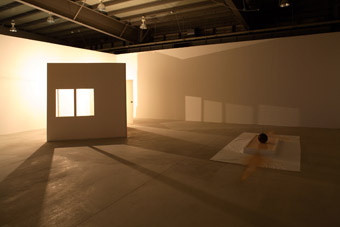
Tony Conrad, Brunelleschi, 2008
photo Keizo Kioku, courtesy of Greene Naftali, New York
Tony Conrad, Brunelleschi, 2008
The faux construction fetish continued into the next room housing Brunelleschi (2008) by Tony Conrad (US) which, along with a replica wall and door construction, featured a Civil War canon ball suspended like a pendulum over a low tray of yellow paint. As the ball swings across the surface the paint is quite daintily dispersed—visually and kinetically interesting. I am told that the wire holding the ball was also amplified, but I admit for once a sonic element passed me by.
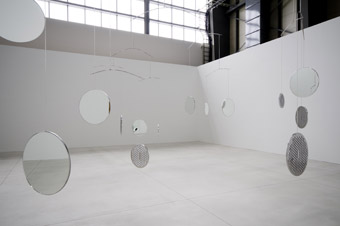
Cerith Wyn Evans and Throbbing Gristle, A=P=P=A=R=I=T=I=O=N
photo Norihiro Ueno, Courtesy of the Artist and Jay Jopling / White Cube, London
Cerith Wyn Evans and Throbbing Gristle, A=P=P=A=R=I=T=I=O=N
A=P=P=A=R=I=T=I=O=N (2008) by Cerith Wyn Evans (UK) broke with the minimalist ethos. Walking around the gently bobbing giant mobile comprising flat discs of mirrors, you’re in for a multi-dimensional sonic and visual experience as your being is fragmented and multiplied, accompanied by the exotic rumblings, text shards and klang of a soundscape by avant art band Throbbing Gristle.
Drawing on a more popular music is The Second Sentence of Everything I Read Is You (2006) by Stephen Prina (US). The sonic element here is a beautiful, multitracked pop song with voices split between individual speakers (in mini Janet Cardiff style), however the physical installation is quite confounding. Designed as a self-contained touring kit, the packing crates turn into large benches with pastel upholstery. The text “…things Felix forgot to tell us…” marked up on the wall alludes to artist Felix Gonzalez-Torres (1957–1996), from whose writings the title is derived. With these elements Prina is suggesting larger issues, as taken up by Gonzalez-Torres, regarding art audiences and art consumption. Perhaps it’s the extreme self-consciousness, the awkwardness of this work that make it so beguiling.
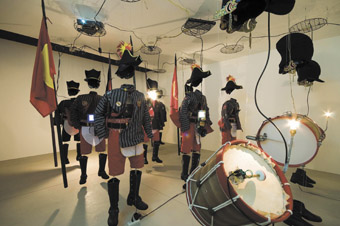
Kuswidananto a.k.a. Jompet, Java’s Machine: PHANTASMAGORIA (2008)
photo Norihiro Ueno, courtesy Yokohama Triennale
Kuswidananto a.k.a. Jompet, Java’s Machine: PHANTASMAGORIA (2008)
Java’s Machine: PHANTASMAGORIA (2008) by Kuswidananto aka Jompet (Indonesia) was perhaps most intriguing for its performativity, and not a performer in sight. Rather there were three rows of automated Javanese palace guards made purely from articles of traditional clothing. Some of these bodiless robots integrated small video screens showing a documentary piece also projected on the walls while two big bass drums played themselves at the front of the contingent. Beautifully constructed from low tech tools, the Disneyland automaton feel took on a strange mix of menace and subversive humour.
Spread across four venues including a site-specific element, Time Crevasses had many hidden joys, and provided an introduction to the cultural resurgence taking place in Yokohama including a new local government supported artist-run gallery district in the former redlight zone. Sitting in the amazing boat-come-hill construction that is the international passenger terminal after my day in Yokohama, I caught sight of two separate suns setting across the water behind me (a reflection of a reflection)—I was in a parallel universe indeed.
Trace Elements: spirit and memory in Japanese and Australian photomedia, curators Bec Dean, Shihoko Iida; Tokyo Opera City, July 19 – Oct 13. Trace Elements: will be presented at Performance, CarriageWorks Sydney Feb 19-March 21 2009, http://www.operacity.jp/ag/exh96/e/index.html
Time Crevasse, Yokohama Triennale 2008, various venues Yokohama, Sept 13 – Nov 30
http://yokohamatriennale.jp/2008/en/
The second stage of the residency-exchange between Artspace and Tokyo Wonder Site will take place at Artspace in Feb-March 2009 with the exhibition opening March 13.
http://www.tokyo-ws.org/english/
http://www.artspace.org.au/
RealTime issue #88 Dec-Jan 2008 pg. 14






